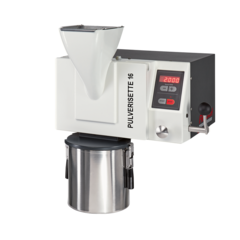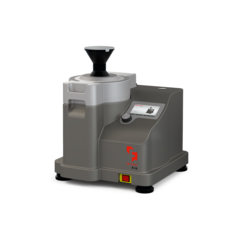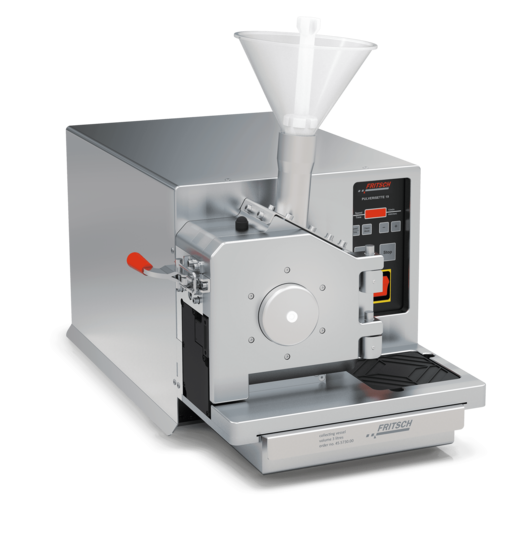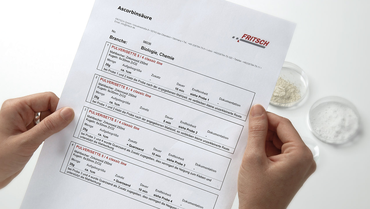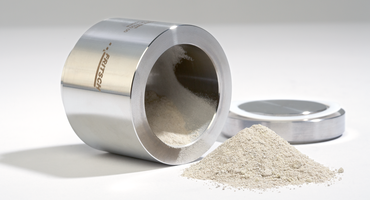Further Rotor / Beater Mills
FURTHER PRODUCT GROUPS
Variable Speed Rotor Mill
PULVERISETTE 14
classic line The Centrifugal Mill PULVERISETTE 14 classic line includes a collecting vessel and lid.
Please note: In order to work with the Variable Speed Rotor Mill you need a rotor and at least one sieve ring.
IMPACT ROTORS MADE OF STAINLESS STEEL
-
Impact rotor
fast comminution of fibrous substances 8-ribs impact rotor feed particle sizes < 10 mm 12-ribs impact rotor fine materials with a feed particle size < 5 mm 24-ribs impact rotor
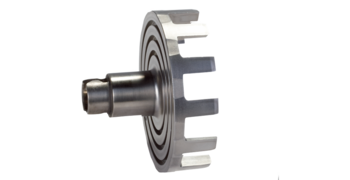
The extremely durable, low-wear, stainless steel rotors are suitable for all standard applications, for comminution of medium-hard, soft, brittle, fibrous substances from lime to plants. To meet various grinding tasks, rotors with 8, 12 and 24 ribs are available.
IMPACT ROTOR MADE OF STAINLESS STEEL
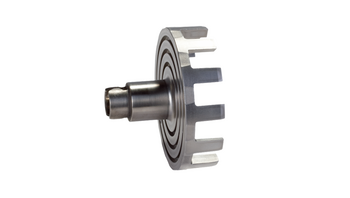
For fast, grinding of fibrous substances.
The following impact rotors made of stainless steel are offered:
12-rib rotor for the grinding of materials with feed particle sizes < 10 mm
24 rib rotor for the grinding of fine materials with feed particle sizes < 5 mm with highest air throughput
| General specifications | |
| Material | Stainless steel – 1.4057 |
| ISO/EN/DIN code | X17CrNi16-2 |
| AISI code | 431 |
| Chemical composition | |
| Element | Share % |
| Iron – Fe | 77.7–80.8 |
| Carbon – C | 0.12–0.22 |
| Silicon – Si | ≤ 1.0 |
| Manganese – Mn | ≤ 1.5 |
| Chromium – Cr | 15–17 |
| Nickel – Ni | 1.5–2.5 |
| Phosphorus – P | ≤ 0.04 |
| Sulphur – S | 0.015 |
| Physical and mechanical properties | |
| Density | 7.7g/cm³ |
| Hardness | 295 HB |
Explanations on hardness data

For the grinding of materials with feed particle sizes < 10 mm.
The following impact rotors made of stainless steel are available:
8-rib rotor for the fast grinding of fibrous substances
24-rib rotor: for the grinding of fine materials with feed particle sizes < 5 mm with highest air throughput
| General specifications | |
| Material | Stainless steel – 1.4057 |
| ISO/EN/DIN code | X17CrNi16-2 |
| AISI code | 431 |
| Chemical composition | |
| Element | Share % |
| Iron – Fe | 77.7–80.8 |
| Carbon – C | 0.12–0.22 |
| Silicon – Si | ≤ 1.0 |
| Manganese – Mn | ≤ 1.5 |
| Chromium – Cr | 15–17 |
| Nickel – Ni | 1.5–2.5 |
| Phosphorus – P | ≤ 0.04 |
| Sulphur – S | 0.015 |
| Physical and mechanical properties | |
| Density | 7.7g/cm³ |
| Hardness | 295 HB |
Explanations on hardness data

For the grinding of fine materials with feed particle sizes < 5 mm with highest air throughput.
The following impact rotors made of stainless steel are available:
8-rib rotor for the fast grinding of fibrous substances
12-rib rotor: for the grinding of samples with feed particle sizes of < 10 mm
| General specifications | |
| Material | Stainless steel – 1.4057 |
| ISO/EN/DIN code | X17CrNi16-2 |
| AISI code | 431 |
| Chemical composition | |
| Element | Share % |
| Iron – Fe | 77.7–80.8 |
| Carbon – C | 0.12–0.22 |
| Silicon – Si | ≤ 1.0 |
| Manganese – Mn | ≤ 1.5 |
| Chromium – Cr | 15–17 |
| Nickel – Ni | 1.5–2.5 |
| Phosphorus – P | ≤ 0.04 |
| Sulphur – S | 0.015 |
| Physical and mechanical properties | |
| Density | 7.7g/cm³ |
| Hardness | 295 HB |
Explanations on hardness data
SIEVE RINGS MADE OF STAINLESS STEEL 316L
-
Sieve rings
Fast comminution of medium hard to soft materials Sieve ring with trapezoidal perforation
for additional shearing effectsFast comminution of brittle materials for achieving medium finenesses Sieve ring with square perforation
for a larger throughput and less sample residue due to the larger, open sieve surface
Sieve ring with round perforation
for narrow grain size rangeHeavy duty loads Sieve rings with reinfored edges

The extremely durable, low-wear, stainless steel sieve rings of the PULVERISETE 14 classic line are suitable for all standard applications, for comminution of medium-hard, soft, brittle, fibrous substances from lime to plants. To meet various grinding tasks, sieve rings with trapezoidal, square or round perforation from 0.08 mm to 6 mm are available.
SIEVE RINGS MADE OF STAINLESS STEEL 316L
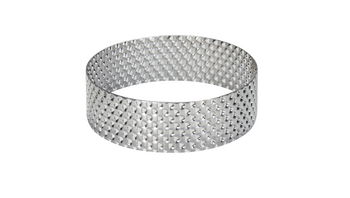
Sieve rings determine the final fineness of the sample.
Sieve rings with trapezoidal perforations are suitable for fast comminution of medium hard to soft materials and improve size reduction through extra shearing action.
Sieve rings with round and square perforations are recommended for the comminution of brittle materials for achieving medium finenesses.
Sieve rings with round perforation achieve during comminution a smaller grain band.
Sieve rings with square perforation often achieve a higher throughput and the sample residue is less compared to sieve rings with round perforation.
Sieve rings with reinforced edges with trapezoidal perforation for heavy duty size reduction are also offered.
| General specifications | |
| Material | Stainless steel – 1.4404/316L |
| ISO/EN/DIN code | X2CrNiMo17-12-2 |
| Chemical composition | |
| Element | Share % |
| Iron – Fe | approx. 62.8 |
| Carbon – C | 0.03 |
| Silicon – Si | 1 |
| Manganese – Mn | 2 |
| Phosphorus – P | 0.045 |
| Sulphur – S | 0.015 |
| Chromium – Cr | 18.5 |
| Molybdenum – Mo | 2.50 |
| Nickel – Ni | 13.00 |
| Nitrogen – N | 0.110 |
| Physical and mechanical properties | |
| Density | 8.0 g/cm³ |
| Hardness | 215 HB |
Explanations on hardness data

Sieve rings determine the final fineness of the sample.
Sieve rings with trapezoidal perforations are suitable for fast comminution of medium hard to soft materials and improve size reduction through extra shearing action.
Sieve rings with round and square perforations are recommended for the comminution of brittle materials for achieving medium finenesses.
Sieve rings with round perforation achieve during comminution a smaller grain band.
Sieve rings with square perforation often achieve a higher throughput and the sample residue is less compared to sieve rings with round perforation.
Sieve rings with reinforced edges with trapezoidal perforation for heavy duty size reduction are also offered.
| General specifications | |
| Material | Stainless steel – 1.4404/316L |
| ISO/EN/DIN code | X2CrNiMo17-12-2 |
| Chemical composition | |
| Element | Share % |
| Iron – Fe | approx. 62.8 |
| Carbon – C | 0.03 |
| Silicon – Si | 1 |
| Manganese – Mn | 2 |
| Phosphorus – P | 0.045 |
| Sulphur – S | 0.015 |
| Chromium – Cr | 18.5 |
| Molybdenum – Mo | 2.50 |
| Nickel – Ni | 13.00 |
| Nitrogen – N | 0.110 |
| Physical and mechanical properties | |
| Density | 8.0 g/cm³ |
| Hardness | 215 HB |
Explanations on hardness data

Sieve rings determine the final fineness of the sample.
Sieve rings with trapezoidal perforations are suitable for fast comminution of medium hard to soft materials and improve size reduction through extra shearing action.
Sieve rings with round and square perforations are recommended for the comminution of brittle materials for achieving medium finenesses.
Sieve rings with round perforation achieve during comminution a smaller grain band.
Sieve rings with square perforation often achieve a higher throughput and the sample residue is less compared to sieve rings with round perforation.
Sieve rings with reinforced edges with trapezoidal perforation for heavy duty size reduction are also offered.
| General specifications | |
| Material | Stainless steel – 1.4404/316L |
| ISO/EN/DIN code | X2CrNiMo17-12-2 |
| Chemical composition | |
| Element | Share % |
| Iron – Fe | approx. 62.8 |
| Carbon – C | 0.03 |
| Silicon – Si | 1 |
| Manganese – Mn | 2 |
| Phosphorus – P | 0.045 |
| Sulphur – S | 0.015 |
| Chromium – Cr | 18.5 |
| Molybdenum – Mo | 2.50 |
| Nickel – Ni | 13.00 |
| Nitrogen – N | 0.110 |
| Physical and mechanical properties | |
| Density | 8.0 g/cm³ |
| Hardness | 215 HB |
Explanations on hardness data

Sieve rings determine the final fineness of the sample.
Sieve rings with trapezoidal perforations are suitable for fast comminution of medium hard to soft materials and improve size reduction through extra shearing action.
Sieve rings with round and square perforations are recommended for the comminution of brittle materials for achieving medium finenesses.
Sieve rings with round perforation achieve during comminution a smaller grain band.
Sieve rings with square perforation often achieve a higher throughput and the sample residue is less compared to sieve rings with round perforation.
Sieve rings with reinforced edges with trapezoidal perforation for heavy duty size reduction are also offered.
| General specifications | |
| Material | Stainless steel – 1.4404/316L |
| ISO/EN/DIN code | X2CrNiMo17-12-2 |
| Chemical composition | |
| Element | Share % |
| Iron – Fe | approx. 62.8 |
| Carbon – C | 0.03 |
| Silicon – Si | 1 |
| Manganese – Mn | 2 |
| Phosphorus – P | 0.045 |
| Sulphur – S | 0.015 |
| Chromium – Cr | 18.5 |
| Molybdenum – Mo | 2.50 |
| Nickel – Ni | 13.00 |
| Nitrogen – N | 0.110 |
| Physical and mechanical properties | |
| Density | 8.0 g/cm³ |
| Hardness | 215 HB |
Explanations on hardness data

Sieve rings determine the final fineness of the sample.
Sieve rings with trapezoidal perforations are suitable for fast comminution of medium hard to soft materials and improve size reduction through extra shearing action.
Sieve rings with round and square perforations are recommended for the comminution of brittle materials for achieving medium finenesses.
Sieve rings with round perforation achieve during comminution a smaller grain band.
Sieve rings with square perforation often achieve a higher throughput and the sample residue is less compared to sieve rings with round perforation.
Sieve rings with reinforced edges with trapezoidal perforation for heavy duty size reduction are also offered.
| General specifications | |
| Material | Stainless steel – 1.4404/316L |
| ISO/EN/DIN code | X2CrNiMo17-12-2 |
| Chemical composition | |
| Element | Share % |
| Iron – Fe | approx. 62.8 |
| Carbon – C | 0.03 |
| Silicon – Si | 1 |
| Manganese – Mn | 2 |
| Phosphorus – P | 0.045 |
| Sulphur – S | 0.015 |
| Chromium – Cr | 18.5 |
| Molybdenum – Mo | 2.50 |
| Nickel – Ni | 13.00 |
| Nitrogen – N | 0.110 |
| Physical and mechanical properties | |
| Density | 8.0 g/cm³ |
| Hardness | 215 HB |
Explanations on hardness data

Sieve rings determine the final fineness of the sample.
Sieve rings with trapezoidal perforations are suitable for fast comminution of medium hard to soft materials and improve size reduction through extra shearing action.
Sieve rings with round and square perforations are recommended for the comminution of brittle materials for achieving medium finenesses.
Sieve rings with round perforation achieve during comminution a smaller grain band.
Sieve rings with square perforation often achieve a higher throughput and the sample residue is less compared to sieve rings with round perforation.
Sieve rings with reinforced edges with trapezoidal perforation for heavy duty size reduction are also offered.
| General specifications | |
| Material | Stainless steel – 1.4404/316L |
| ISO/EN/DIN code | X2CrNiMo17-12-2 |
| Chemical composition | |
| Element | Share % |
| Iron – Fe | approx. 62.8 |
| Carbon – C | 0.03 |
| Silicon – Si | 1 |
| Manganese – Mn | 2 |
| Phosphorus – P | 0.045 |
| Sulphur – S | 0.015 |
| Chromium – Cr | 18.5 |
| Molybdenum – Mo | 2.50 |
| Nickel – Ni | 13.00 |
| Nitrogen – N | 0.110 |
| Physical and mechanical properties | |
| Density | 8.0 g/cm³ |
| Hardness | 215 HB |
Explanations on hardness data

Sieve rings determine the final fineness of the sample.
Sieve rings with trapezoidal perforations are suitable for fast comminution of medium hard to soft materials and improve size reduction through extra shearing action.
Sieve rings with round and square perforations are recommended for the comminution of brittle materials for achieving medium finenesses.
Sieve rings with round perforation achieve during comminution a smaller grain band.
Sieve rings with square perforation often achieve a higher throughput and the sample residue is less compared to sieve rings with round perforation.
Sieve rings with reinforced edges with trapezoidal perforation for heavy duty size reduction are also offered.
| General specifications | |
| Material | Stainless steel – 1.4404/316L |
| ISO/EN/DIN code | X2CrNiMo17-12-2 |
| Chemical composition | |
| Element | Share % |
| Iron – Fe | approx. 62.8 |
| Carbon – C | 0.03 |
| Silicon – Si | 1 |
| Manganese – Mn | 2 |
| Phosphorus – P | 0.045 |
| Sulphur – S | 0.015 |
| Chromium – Cr | 18.5 |
| Molybdenum – Mo | 2.50 |
| Nickel – Ni | 13.00 |
| Nitrogen – N | 0.110 |
| Physical and mechanical properties | |
| Density | 8.0 g/cm³ |
| Hardness | 215 HB |
Explanations on hardness data

Sieve rings determine the final fineness of the sample.
Sieve rings with trapezoidal perforations are suitable for fast comminution of medium hard to soft materials and improve size reduction through extra shearing action.
Sieve rings with round and square perforations are recommended for the comminution of brittle materials for achieving medium finenesses.
Sieve rings with round perforation achieve during comminution a smaller grain band.
Sieve rings with square perforation often achieve a higher throughput and the sample residue is less compared to sieve rings with round perforation.
Sieve rings with reinforced edges with trapezoidal perforation for heavy duty size reduction are also offered.
| General specifications | |
| Material | Stainless steel – 1.4404/316L |
| ISO/EN/DIN code | X2CrNiMo17-12-2 |
| Chemical composition | |
| Element | Share % |
| Iron – Fe | approx. 62.8 |
| Carbon – C | 0.03 |
| Silicon – Si | 1 |
| Manganese – Mn | 2 |
| Phosphorus – P | 0.045 |
| Sulphur – S | 0.015 |
| Chromium – Cr | 18.5 |
| Molybdenum – Mo | 2.50 |
| Nickel – Ni | 13.00 |
| Nitrogen – N | 0.110 |
| Physical and mechanical properties | |
| Density | 8.0 g/cm³ |
| Hardness | 215 HB |
Explanations on hardness data

Sieve rings determine the final fineness of the sample.
Sieve rings with round and square perforations are recommended for the comminution of brittle materials for achieving medium finenesses.
Sieve rings with square perforation often achieve a higher throughput and the sample residue is less compared to sieve rings with round perforation.
Sieve rings with round perforation achieve during comminution a smaller grain band.
Sieve rings with trapezoidal perforations are suitable for fast comminution of medium hard to soft materials and improve size reduction through extra shearing action.
Sieve rings with reinforced edges with trapezoidal perforation for heavy duty size reduction are also offered.
| General specifications | |
| Material | Stainless steel – 1.4404/316L |
| ISO/EN/DIN code | X2CrNiMo17-12-2 |
| Chemical composition | |
| Element | Share % |
| Iron – Fe | approx. 62.8 |
| Carbon – C | 0.03 |
| Silicon – Si | 1 |
| Manganese – Mn | 2 |
| Phosphorus – P | 0.045 |
| Sulphur – S | 0.015 |
| Chromium – Cr | 18.5 |
| Molybdenum – Mo | 2.50 |
| Nickel – Ni | 13.00 |
| Nitrogen – N | 0.110 |
| Physical and mechanical properties | |
| Density | 8.0 g/cm³ |
| Hardness | 215 HB |
Explanations on hardness data

Sieve rings determine the final fineness of the sample.
Sieve rings with square perforation are recommended for the comminution of brittle materials for achieving medium fineness, but often achieve a higher throughput and the sample residue is less compared to sieve rings with round perforation.
Sieve rings with round perforation are recommended for reduction of brittle materials for achieving medium fineness in a smaller grain band.
Sieve rings with trapezoidal perforations are suitable for fast comminution of medium hard to soft materials and improve size reduction through extra shearing action.
Sieve rings with reinforced edges with trapezoidal perforation for heavy duty size reduction are also offered.
| General specifications | |
| Material | Stainless steel – 1.4404/316L |
| ISO/EN/DIN code | X2CrNiMo17-12-2 |
| Chemical composition | |
| Element | Share % |
| Iron – Fe | approx. 62.8 |
| Carbon – C | 0.03 |
| Silicon – Si | 1 |
| Manganese – Mn | 2 |
| Phosphorus – P | 0.045 |
| Sulphur – S | 0.015 |
| Chromium – Cr | 18.5 |
| Molybdenum – Mo | 2.50 |
| Nickel – Ni | 13.00 |
| Nitrogen – N | 0.110 |
| Physical and mechanical properties | |
| Density | 8.0 g/cm³ |
| Hardness | 215 HB |
Explanations on hardness data

Sieve rings determine the final fineness of the sample.
Sieve rings with round and square perforations are recommended for the comminution of brittle materials for achieving medium finenesses.
Sieve rings with square perforation often achieve a higher throughput and the sample residue is less compared to sieve rings with round perforation.
Sieve rings with round perforation achieve during comminution a smaller grain band.
Sieve rings with trapezoidal perforations are suitable for fast comminution of medium hard to soft materials and improve size reduction through extra shearing action.
Sieve rings with reinforced edges with trapezoidal perforation for heavy duty size reduction are also offered.
| General specifications | |
| Material | Stainless steel – 1.4404/316L |
| ISO/EN/DIN code | X2CrNiMo17-12-2 |
| Chemical composition | |
| Element | Share % |
| Iron – Fe | approx. 62.8 |
| Carbon – C | 0.03 |
| Silicon – Si | 1 |
| Manganese – Mn | 2 |
| Phosphorus – P | 0.045 |
| Sulphur – S | 0.015 |
| Chromium – Cr | 18.5 |
| Molybdenum – Mo | 2.50 |
| Nickel – Ni | 13.00 |
| Nitrogen – N | 0.110 |
| Physical and mechanical properties | |
| Density | 8.0 g/cm³ |
| Hardness | 215 HB |
Explanations on hardness data

Sieve rings determine the final fineness of the sample.
Sieve rings with round and square perforations are recommended for the comminution of brittle materials for achieving medium finenesses.
Sieve rings with round perforation achieve during comminution a smaller grain band.
Sieve rings with square perforation often achieve a higher throughput and the sample residue is less compared to sieve rings with round perforation.
Sieve rings with trapezoidal perforations are suitable for fast comminution of medium hard to soft materials and improve size reduction through extra shearing action.
Sieve rings with reinforced edges with trapezoidal perforation for heavy duty size reduction are also offered.
| General specifications | |
| Material | Stainless steel – 1.4404/316L |
| ISO/EN/DIN code | X2CrNiMo17-12-2 |
| Chemical composition | |
| Element | Share % |
| Iron – Fe | approx. 62.8 |
| Carbon – C | 0.03 |
| Silicon – Si | 1 |
| Manganese – Mn | 2 |
| Phosphorus – P | 0.045 |
| Sulphur – S | 0.015 |
| Chromium – Cr | 18.5 |
| Molybdenum – Mo | 2.50 |
| Nickel – Ni | 13.00 |
| Nitrogen – N | 0.110 |
| Physical and mechanical properties | |
| Density | 8.0 g/cm³ |
| Hardness | 215 HB |
Explanations on hardness data

Sieve rings determine the final fineness of the sample.
Sieve rings with round and square perforations are recommended for the comminution of brittle materials for achieving medium finenesses.
Sieve rings with round perforation achieve during comminution a smaller grain band.
Sieve rings with square perforation often achieve a higher throughput and the sample residue is less compared to sieve rings with round perforation.
Sieve rings with trapezoidal perforations are suitable for fast comminution of medium hard to soft materials and improve size reduction through extra shearing action.
Sieve rings with reinforced edges with trapezoidal perforation for heavy duty size reduction are also offered.
| General specifications | |
| Material | Stainless steel – 1.4404/316L |
| ISO/EN/DIN code | X2CrNiMo17-12-2 |
| Chemical composition | |
| Element | Share % |
| Iron – Fe | approx. 62.8 |
| Carbon – C | 0.03 |
| Silicon – Si | 1 |
| Manganese – Mn | 2 |
| Phosphorus – P | 0.045 |
| Sulphur – S | 0.015 |
| Chromium – Cr | 18.5 |
| Molybdenum – Mo | 2.50 |
| Nickel – Ni | 13.00 |
| Nitrogen – N | 0.110 |
| Physical and mechanical properties | |
| Density | 8.0 g/cm³ |
| Hardness | 215 HB |
Explanations on hardness data

Sieve rings determine the final fineness of the sample. e.
Sieve rings with round and square perforations are recommended for the comminution of brittle materials for achieving medium finenesses.
Sieve rings with round perforation achieve during comminution a smaller grain band.
Sieve rings with square perforation often achieve a higher throughput and the sample residue is less compared to sieve rings with round perforation.
Sieve rings with trapezoidal perforations are suitable for fast comminution of medium hard to soft materials and improve size reduction through extra shearing action.
Sieve rings with reinforced edges with trapezoidal perforation for heavy duty size reduction are also offered.
| General specifications | |
| Material | Stainless steel – 1.4404/316L |
| ISO/EN/DIN code | X2CrNiMo17-12-2 |
| Chemical composition | |
| Element | Share % |
| Iron – Fe | approx. 62.8 |
| Carbon – C | 0.03 |
| Silicon – Si | 1 |
| Manganese – Mn | 2 |
| Phosphorus – P | 0.045 |
| Sulphur – S | 0.015 |
| Chromium – Cr | 18.5 |
| Molybdenum – Mo | 2.50 |
| Nickel – Ni | 13.00 |
| Nitrogen – N | 0.110 |
| Physical and mechanical properties | |
| Density | 8.0 g/cm³ |
| Hardness | 215 HB |
Explanations on hardness data

Sieve rings determine the final fineness of the sample.
Sieve rings with round and square perforations are recommended for the comminution of brittle materials for achieving medium finenesses.
Sieve rings with round perforation achieve during comminution a smaller grain band.
Sieve rings with square perforation often achieve a higher throughput and the sample residue is less compared to sieve rings with round perforation.
Sieve rings with trapezoidal perforations are suitable for fast comminution of medium hard to soft materials and improve size reduction through extra shearing action.
Sieve rings with reinforced edges with trapezoidal perforation for heavy duty size reduction are also offered.
| General specifications | |
| Material | Stainless steel – 1.4404/316L |
| ISO/EN/DIN code | X2CrNiMo17-12-2 |
| Chemical composition | |
| Element | Share % |
| Iron – Fe | approx. 62.8 |
| Carbon – C | 0.03 |
| Silicon – Si | 1 |
| Manganese – Mn | 2 |
| Phosphorus – P | 0.045 |
| Sulphur – S | 0.015 |
| Chromium – Cr | 18.5 |
| Molybdenum – Mo | 2.50 |
| Nickel – Ni | 13.00 |
| Nitrogen – N | 0.110 |
| Physical and mechanical properties | |
| Density | 8.0 g/cm³ |
| Hardness | 215 HB |
Explanations on hardness data
SIEVE RINGS WITH REINFORCED EDGES FOR HEAVY DUTY Loads MADE OF STAINLESS STEEL 316L
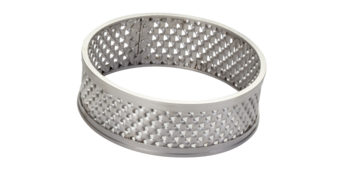
For particularly heavy duty loads, during the grinding of harder materials, all sieve rings up to 2 mm trapezoidal perforation are available with additional reinforced edges.
SIEVE RINGS WITH REINFORCED EDGES FOR HEAVY DUTY LOADS MADE OF STAINLESS STEEL 316L

For heavy duty use.
Sieve rings determine the end fineness of the sample.
Sieve rings for heavy duty use with reinforced edges are offered with trapezoidal perforations.
Sieve rings with trapezoidal perforations improve size reduction through extra shearing action.
| General specifications | |
| Material | Stainless steel – 1.4404/316L |
| ISO/EN/DIN code | X2CrNiMo17-12-2 |
| Chemical composition | |
| Element | Share % |
| Iron – Fe | approx. 62.8 |
| Carbon – C | 0.03 |
| Silicon – Si | 1 |
| Manganese – Mn | 2 |
| Phosphorus – P | 0.045 |
| Sulphur – S | 0.015 |
| Chromium – Cr | 18.5 |
| Molybdenum – Mo | 2.50 |
| Nickel – Ni | 13.00 |
| Nitrogen – N | 0.110 |
| Physical and mechanical properties | |
| Density | 8.0 g/cm³ |
| Hardness | 215 HB |
Explanations on hardness data

For heavy duty use.
Sieve rings determine the end fineness of the sample.
Sieve rings for heavy duty use with reinforced edges are offered with trapezoidal perforations.
Sieve rings with trapezoidal perforations improve size reduction through extra shearing action.
| General specifications | |
| Material | Stainless steel – 1.4404/316L |
| ISO/EN/DIN code | X2CrNiMo17-12-2 |
| Chemical composition | |
| Element | Share % |
| Iron – Fe | approx. 62.8 |
| Carbon – C | 0.03 |
| Silicon – Si | 1 |
| Manganese – Mn | 2 |
| Phosphorus – P | 0.045 |
| Sulphur – S | 0.015 |
| Chromium – Cr | 18.5 |
| Molybdenum – Mo | 2.50 |
| Nickel – Ni | 13.00 |
| Nitrogen – N | 0.110 |
| Physical and mechanical properties | |
| Density | 8.0 g/cm³ |
| Hardness | 215 HB |
Explanations on hardness data

For heavy duty use.
Sieve rings determine the end fineness of the sample.
Sieve rings for heavy duty use with reinforced edges are offered with trapezoidal perforations.
Sieve rings with trapezoidal perforations improve size reduction through extra shearing action.
| General specifications | |
| Material | Stainless steel – 1.4404/316L |
| ISO/EN/DIN code | X2CrNiMo17-12-2 |
| Chemical composition | |
| Element | Share % |
| Iron – Fe | approx. 62.8 |
| Carbon – C | 0.03 |
| Silicon – Si | 1 |
| Manganese – Mn | 2 |
| Phosphorus – P | 0.045 |
| Sulphur – S | 0.015 |
| Chromium – Cr | 18.5 |
| Molybdenum – Mo | 2.50 |
| Nickel – Ni | 13.00 |
| Nitrogen – N | 0.110 |
| Physical and mechanical properties | |
| Density | 8.0 g/cm³ |
| Hardness | 215 HB |
Explanations on hardness data

For heavy duty use.
Sieve rings determine the end fineness of the sample.
Sieve rings for heavy duty use with reinforced edges are offered with trapezoidal perforations.
Sieve rings with trapezoidal perforations improve size reduction through extra shearing action.
| General specifications | |
| Material | Stainless steel – 1.4404/316L |
| ISO/EN/DIN code | X2CrNiMo17-12-2 |
| Chemical composition | |
| Element | Share % |
| Iron – Fe | approx. 62.8 |
| Carbon – C | 0.03 |
| Silicon – Si | 1 |
| Manganese – Mn | 2 |
| Phosphorus – P | 0.045 |
| Sulphur – S | 0.015 |
| Chromium – Cr | 18.5 |
| Molybdenum – Mo | 2.50 |
| Nickel – Ni | 13.00 |
| Nitrogen – N | 0.110 |
| Physical and mechanical properties | |
| Density | 8.0 g/cm³ |
| Hardness | 215 HB |
Explanations on hardness data

For heavy duty use.
Sieve rings determine the end fineness of the sample.
Sieve rings for heavy duty use with reinforced edges are offered with trapezoidal perforations.
Sieve rings with trapezoidal perforations improve size reduction through extra shearing action.
| General specifications | |
| Material | Stainless steel – 1.4404/316L |
| ISO/EN/DIN code | X2CrNiMo17-12-2 |
| Chemical composition | |
| Element | Share % |
| Iron – Fe | approx. 62.8 |
| Carbon – C | 0.03 |
| Silicon – Si | 1 |
| Manganese – Mn | 2 |
| Phosphorus – P | 0.045 |
| Sulphur – S | 0.015 |
| Chromium – Cr | 18.5 |
| Molybdenum – Mo | 2.50 |
| Nickel – Ni | 13.00 |
| Nitrogen – N | 0.110 |
| Physical and mechanical properties | |
| Density | 8.0 g/cm³ |
| Hardness | 215 HB |
Explanations on hardness data

For heavy duty use.
Sieve rings determine the end fineness of the sample.
Sieve rings for heavy duty use with reinforced edges are offered with trapezoidal perforations.
Sieve rings with trapezoidal perforations improve size reduction through extra shearing action.
| General specifications | |
| Material | Stainless steel – 1.4404/316L |
| ISO/EN/DIN code | X2CrNiMo17-12-2 |
| Chemical composition | |
| Element | Share % |
| Iron – Fe | approx. 62.8 |
| Carbon – C | 0.03 |
| Silicon – Si | 1 |
| Manganese – Mn | 2 |
| Phosphorus – P | 0.045 |
| Sulphur – S | 0.015 |
| Chromium – Cr | 18.5 |
| Molybdenum – Mo | 2.50 |
| Nickel – Ni | 13.00 |
| Nitrogen – N | 0.110 |
| Physical and mechanical properties | |
| Density | 8.0 g/cm³ |
| Hardness | 215 HB |
Explanations on hardness data

For heavy duty use.
Sieve rings determine the end fineness of the sample.
Sieve rings for heavy duty use with reinforced edges are offered with trapezoidal perforations.
Sieve rings with trapezoidal perforations improve size reduction through extra shearing action.
| General specifications | |
| Material | Stainless steel – 1.4404/316L |
| ISO/EN/DIN code | X2CrNiMo17-12-2 |
| Chemical composition | |
| Element | Share % |
| Iron – Fe | approx. 62.8 |
| Carbon – C | 0.03 |
| Silicon – Si | 1 |
| Manganese – Mn | 2 |
| Phosphorus – P | 0.045 |
| Sulphur – S | 0.015 |
| Chromium – Cr | 18.5 |
| Molybdenum – Mo | 2.50 |
| Nickel – Ni | 13.00 |
| Nitrogen – N | 0.110 |
| Physical and mechanical properties | |
| Density | 8.0 g/cm³ |
| Hardness | 215 HB |
Explanations on hardness data

For heavy duty use.
Sieve rings determine the end fineness of the sample.
Sieve rings for heavy duty use with reinforced edges are offered with trapezoidal perforations.
Sieve rings with trapezoidal perforations improve size reduction through extra shearing action.
| General specifications | |
| Material | Stainless steel – 1.4404/316L |
| ISO/EN/DIN code | X2CrNiMo17-12-2 |
| Chemical composition | |
| Element | Share % |
| Iron – Fe | approx. 62.8 |
| Carbon – C | 0.03 |
| Silicon – Si | 1 |
| Manganese – Mn | 2 |
| Phosphorus – P | 0.045 |
| Sulphur – S | 0.015 |
| Chromium – Cr | 18.5 |
| Molybdenum – Mo | 2.50 |
| Nickel – Ni | 13.00 |
| Nitrogen – N | 0.110 |
| Physical and mechanical properties | |
| Density | 8.0 g/cm³ |
| Hardness | 215 HB |
Explanations on hardness data
ACCESSORIES FOR HEAVY-METAL AND IRON-FREE GRINDING AND SAMPLE PREPARATION ACCORDING TO ROHS
-
Heavy-metal-free and iron-free grinding and sample preparation
For grinding soft samples like leaves, grain and soft foods select additionally a 12-rib impact rotor and a sieve ring with reinforced edges made of pure titanium with a matching perforation for the desired final fineness For grinding medium-hard samples like rice, wood, leather or plastics select additionally a sieve ring TiN-coated and for feed particle sizes < 10 mm a 12-rib rotor and for feed particle sizes < 5 mm a 24-rib rotor TiN-coated Sample preparation according to RoHS Select a sieve ring and rotor TiN-coated and for feed particle sizes < 10 mm use a 12-rib rotor and for feed particle sizes < 5 mm a 24-rib rotor
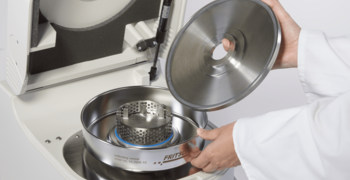
For heavy-metal-free and iron-free grinding and sample preparation according to RoHS, you can order your PULVERISETTE 14 classic line with a PTFE-coated lid and collecting vessel and corresponding impact rotor and sieve ring.
ACCESSORIES FOR HEAVY-METAL AND IRON-FREE GRINDING AND SAMPLE PREPARATION ACCORDING TO ROHS
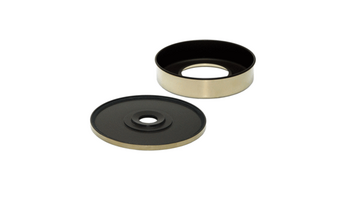
Heavy-metal- and iron-free grinding
For both: heavy-metal-free and iron-free grinding you can order your PULVERISETTE 14 classic line with a PTFE-coated lid and collecting vessel:
For grinding soft samples like leaves, grain and soft foods select additionally a 12-rib impact rotor and a sieve ring with reinforced edges made of pure titanium with a matching perforation for the desired final fineness.
For grinding medium-hard samples like rice, wood, leather or plastics select additionally a sieve ring TiN-coated and for feed particle sizes < 10 mm a 12-rib rotor and for feed particle sizes < 5 mm a 24-rib rotor TiN-coated.
| General specifications | |
| Material | PTFE |
| CAS Number | 9002-84-0 |
| Chemical composition | |
| Element | Formula |
| Polytetrafluoroethylene | C 2F4 |
| Melting point | 327° C |
| Max. application temp. constant | 260° C |
| Max. application temp. briefly | 300° C |
| Physical and mechanical properties | |
| Density | 2.16 g /cm³ |
| Ball pressure hardness | ISO 868, ISO 2039-2, D 55 Shore |
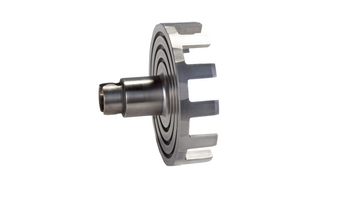
For heavy-metal- and iron-free grinding of soft materials such as leaves, grains and soft foods.
Order with the 12-ribs pure titanium impact rotor, a pure titanium sieve ring with reinforced edges, available with 0.2 mm, 0.5 mm, 1 mm and 2 mm trapezoidal perforations.
Also needed is a PTFE-coated lid and PTFE-coated collecting pan, order no. 14.3750.00.
| General specifications | |
| Material | Pure titanium – 3.7035 – Ti 2 |
| ISO/EN/DIN code | DIN 17861 |
| Chemical composition | |
| Element | Share % |
| Titanium – Ti | 99.4 – 99.5 |
| Oxygen – O | 0.18 |
| Nitrogen – N | 0.05 |
| Carbon – C | 0.06 |
| Hydrogen – H | 0.013 |
| Iron - Fe | 0.2 |
| Physical and mechanical properties | |
| Density | 4.5 g/cm³ |
| Hardness / Brinell guide value HB 30 | 150 Brinell hardness |
Explanations on hardness data

For heavy duty loads for the heavy-metal-free and iron-free grinding of soft materials such as leaves, grains and soft foods.
Sieve rings determine the end fineness of the sample. Pure titanium sieve rings with reinforced edges for heavy duty loads are offered with trapezoidal perforations. Sieve rings with trapezoidal perforations improve size reduction through extra shearing action.
Additionally, sieve rings made of pure titanium with 0.5 mm, 1 mm and 2 mm trapezoidal perforation and an impact rotor with 12 ribs made of pure titanium can be ordered.
Also a PTFE-coated lid and collecting pan are available as a set (Order No. 14.3750.00).
| General specifications | |
| Material | Pure titanium – 3.7035 – Ti 2 |
| ISO/EN/DIN code | DIN 17861 |
| Chemical composition | |
| Element | Share % |
| Titanium – Ti | 99.4 – 99.5 |
| Oxygen – O | 0.18 |
| Nitrogen – N | 0.05 |
| Carbon – C | 0.06 |
| Hydrogen – H | 0.013 |
| Iron - Fe | 0.2 |
| Physical and mechanical properties | |
| Density | 4.5 g/cm³ |
| Hardness / Brinell guide value HB 30 | 150 Brinell hardness |
Explanations on hardness data

For heavy duty loads for the heavy-metal-free and iron-free grinding of soft materials such as leaves, grains and soft foods.
Sieve rings determine the end fineness of the sample. Pure titanium sieve rings with reinforced edges for heavy duty loads are offered with trapezoidal perforations. Sieve rings with trapezoidal perforations improve size reduction through extra shearing action.
Additionally, sieve rings made of pure titanium with 0.2 mm, 1 mm and 2 mm trapezoidal perforation and an impact rotor with 12 ribs made of pure titanium can be ordered.
Also a PTFE-coated lid and collecting pan are available as a set (Order No. 14.3750.00).
| General specifications | |
| Material | Pure titanium – 3.7035 – Ti 2 |
| ISO/EN/DIN code | DIN 17861 |
| Chemical composition | |
| Element | Share % |
| Titanium – Ti | 99.4 – 99.5 |
| Oxygen – O | 0.18 |
| Nitrogen – N | 0.05 |
| Carbon – C | 0.06 |
| Hydrogen – H | 0.013 |
| Iron - Fe | 0.2 |
| Physical and mechanical properties | |
| Density | 4.5 g/cm³ |
| Hardness / Brinell guide value HB 30 | 150 Brinell hardness |
Explanations on hardness data

For heavy duty loads for the heavy-metal-free and iron-free grinding of soft materials such as leaves, grains and soft foods.
Sieve rings determine the end fineness of the sample. Pure titanium sieve rings with reinforced edges for heavy duty loads are offered with trapezoidal perforations. Sieve rings with trapezoidal perforations improve size reduction through extra shearing action.
Additionally, sieve rings made of pure titanium with 0.2 mm, 0.5 mm and 2 mm trapezoidal perforation and an impact rotor with 12 ribs made of pure titanium can be ordered.
Also a PTFE-coated lid and collecting pan are available as a set (Order No. 14.3750.00).
| General specifications | |
| Material | Pure titanium – 3.7035 – Ti 2 |
| ISO/EN/DIN code | DIN 17861 |
| Chemical composition | |
| Element | Share % |
| Titanium – Ti | 99.4 – 99.5 |
| Oxygen – O | 0.18 |
| Nitrogen – N | 0.05 |
| Carbon – C | 0.06 |
| Hydrogen – H | 0.013 |
| Iron - Fe | 0.2 |
| Physical and mechanical properties | |
| Density | 4.5 g/cm³ |
| Hardness / Brinell guide value HB 30 | 150 Brinell hardness |
Explanations on hardness data

For heavy duty loads for the heavy-metal-free and iron-free grinding of soft materials such as leaves, grains and soft foods.
Sieve rings determine the end fineness of the sample. Pure titanium sieve rings with reinforced edges for heavy duty loads are offered with trapezoidal perforations. Sieve rings with trapezoidal perforations improve size reduction through extra shearing action.
Additionally, sieve rings made of pure titanium with 0.2 mm, 0.5 mm and 1 mm trapezoidal perforation and an impact rotor with 12 ribs made of pure titanium can be ordered.
Also a PTFE-coated lid and collecting pan are available as a set (Order No. 14.3750.00).
| General specifications | |
| Material | Pure titanium – 3.7035 – Ti 2 |
| ISO/EN/DIN code | DIN 17861 |
| Chemical composition | |
| Element | Share % |
| Titanium – Ti | 99.4 – 99.5 |
| Oxygen – O | 0.18 |
| Nitrogen – N | 0.05 |
| Carbon – C | 0.06 |
| Hydrogen – H | 0.013 |
| Iron - Fe | 0.2 |
| Physical and mechanical properties | |
| Density | 4.5 g/cm³ |
| Hardness / Brinell guide value HB 30 | 150 Brinell hardness |
Explanations on hardness data

Heavy-metal- and iron-free grinding: For grinding medium-hard samples like rice, wood, leather or plastics for feed particle sizes < 10 mm.
Along with the TiN-coated 12-rib rotor, additionally select a sieve ring also TiN-coated (available with 0.12 mm, 0.2 mm, 0.5 mm und 1 mm trapezoidal perforation).
For feed particle sizes < 5 mm, a TiN-coated 24-rib rotor is available: order no. 44.4240.00.
RoHS: For sample preparation according to RoHS – such as for verification of hexavalent chromium, for feed particle sizes < 10 mm.
Select along with the TiN-coated 12 rib-rotor, a sieve ring also TiN-coated (available with 0.12 mm, 0.2 mm, 0.5 mm und 1 mm trapezoidal perforation).
For feed particle sizes < 5 mm, a TiN-coated 24-rib rotor is available: order no. 44.4240.00.
Please note: for heavy-metal-iron-free grinding and sample preparation according to RoHS, a PTFE-coated lid and collecting vessel are always required, order no. 14.3750.00.
| General specifications | |
| Material | Titanium nitride – TiN |
| ISO/EN/DIN code | |
| Chemical composition | |
| Element | Share % |
| Titanium nitride TiN | 100 |

Heavy-metal- and iron-free grinding: For grinding medium-hard samples like rice, wood, leather or plastics for feed particle sizes < 5 mm.
Along with the TiN-coated 24-rib rotor, additionally select a sieve ring also TiN-coated (available with 0.12 mm, 0.2 mm, 0.5 mm und 1 mm trapezoidal perforation).
For feed particle sizes < 10 mm, a TiN-coated 12-rib rotor is available: order no. 44.4120.00.
RoHS: For sample preparation according to RoHS – such as for verification of hexavalent chromium, for feed particle sizes < 5 mm.
Select along with the TiN-coated 24 rib-rotor, a sieve ring also TiN-coated (available with 0.12 mm, 0.2 mm, 0.5 mm und 1 mm trapezoidal perforation).
For feed particle sizes < 10 mm, a TiN-coated 12-rib rotor is available: order no. 44.4120.00.
Please note: for heavy-metal-iron-free grinding and sample preparation according to RoHS, a PTFE-coated lid and collecting vessel are always required, order no. 14.3750.00.
| General specifications | |
| Material | Titanium nitride – TiN |
| ISO/EN/DIN code | |
| Chemical composition | |
| Element | Share % |
| Titanium nitride TiN | 100 |

For heavy-metal and iron-free grinding of medium-hard materials such as rice, wood, leather or plastics and for sample preparation according to RoHS – such as for verification of hexavalent chromium.
Sieve rings determine the end fineness of the sample.
Sieve rings TiN-coated are offered with trapezoidal perforation. The trapezoidal perforations improve size reduction through extra shearing action.
Additionally, sieve rings TiN-coated with 0.2 mm, 0.5 mm and 1 mm trapezoidal perforations and impact rotors with 12 and 24 ribs, TiN-coated can be ordered.
Please note: for heavy-metal-iron-free grinding and sample preparation according to RoHS, a PTFE-coated lid and collecting vessel are always required, order no. 14.3750.00.
| General specifications | |
| Material | Titanium nitride – TiN |
| ISO/EN/DIN code | |
| Chemical composition | |
| Element | Share % |
| Titanium nitride TiN | 100 |

For heavy-metal and iron-free grinding of medium-hard materials such as rice, wood, leather or Plastics and for sample preparation according to RoHS – such as for verification of hexavalent chromium.
Sieve rings determine the end fineness of the sample.
Sieve rings TiN-coated are offered with trapezoidal perforation. The trapezoidal perforations improve size reduction through extra shearing action.
Additionally, sieve rings TiN-coated with 0.12 mm, 0.5 mm and 1 mm trapezoidal perforations and impact rotors with 12 and 24 ribs, TiN-coated can be ordered.
Please note: for heavy-metal-iron-free grinding and sample preparation according to RoHS, a PTFE-coated lid and collecting vessel are always required, order no. 14.3750.00.
| General specifications | |
| Material | Titanium nitride – TiN |
| ISO/EN/DIN code | |
| Chemical composition | |
| Element | Share % |
| Titanium nitride TiN | 100 |

For heavy-metal and iron-free grinding of medium-hard materials such as rice, wood, leather or Plastics and for sample preparation according to RoHS – such as for verification of hexavalent chromium.
Sieve rings determine the end fineness of the sample.
Sieve rings TiN-coated are offered with trapezoidal perforation.
The trapezoidal perforations improve size reduction through extra shearing action.
Additionally, sieve rings TiN-coated with 0.12 mm, 0.2 mm and 1 mm trapezoidal perforations and impact rotors with 12 and 24 ribs, TiN-coated can be ordered.
Please note: for heavy-metal-iron-free grinding and sample preparation according to RoHS, a PTFE-coated lid and collecting vessel are always required, order no. 14.3750.00.
| General specifications | |
| Material | Titanium nitride – TiN |
| ISO/EN/DIN code | |
| Chemical composition | |
| Element | Share % |
| Titanium nitride TiN | 100 |

For heavy-metal and iron-free grinding of medium-hard materials such as rice, wood, leather or plastics.
Sieve rings determine the end fineness of the sample and for sample preparation according to RoHS – such as for verification of hexavalent chromium.
Sieve rings TiN-coated are offered with trapezoidal perforation. The trapezoidal perforations improve size reduction through extra shearing action.
Additionally, sieve rings TiN-coated with 0.12 mm, 0.2 mm and 0.5 mm trapezoidal perforations and impact rotors with 12 and 24 ribs, TiN-coated can be ordered.
Please note: for heavy-metal-iron-free grinding and sample preparation according to RoHS, a PTFE-coated lid and collecting vessel are always required, order no. 14.3750.00.
| General specifications | |
| Material | Titanium nitride – TiN |
| ISO/EN/DIN code | |
| Chemical composition | |
| Element | Share % |
| Titanium nitride TiN | 100 |
ACCESSORIES FOR DIFFICULT-TO-MILL AND TEMPERATURE-SENSITIVE SAMPLES
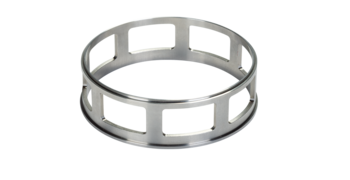
The FRITSCH impact bar enables together with a sieve ring a very gentle comminution of the sample which in many cases would be impossible without the impact bar. The bar acts as a stator on which the material is additionally beaten.
Ideal for especially heat-sensitive materials such as powder coatings or plastics as well as for smooth pre-crushing and fine comminution of hard-brittle to soft, fatty or samples with residual moisture. The corresponding rotor and sieve ring for the impact bar must be ordered separately.
IMPACT BAR FOR DIFFICULT-TO-MILL AND TEMPERATURE-SENSITIVE SAMPLES

For difficult-to-mill samples, temperature-sensitive samples and plastics
The impact bar enables together with a sieve ring a very gentle comminution of the sample. The bar acts as a stator on which the material is additionally beaten. The result: increased grinding performance for a particularly fast and effective grinding that minimises the thermal load. Ideal for especially heat-sensitive materials such as powder coatings or plastics as well as for smooth pre-crushing and fine comminution of hard-brittle to soft, fatty or samples with residual moisture.
(Please note: impact rotor and special sieve ring are additionally necessary!)
| General specifications | |
| Material | Stainless steel – 1.4057 |
| ISO/EN/DIN code | X17CrNi16-2 |
| AISI code | 431 |
| Chemical composition | |
| Element | Share % |
| Iron – Fe | 77.7–80.8 |
| Carbon – C | 0.12–0.22 |
| Silicon – Si | ≤ 1.0 |
| Manganese – Mn | ≤ 1.5 |
| Chromium – Cr | 15–17 |
| Nickel – Ni | 1.5–2.5 |
| Phosphorus – P | ≤ 0.04 |
| Sulphur – S | 0.015 |
| Physical and mechanical properties | |
| Density | 7.7g/cm³ |
| Hardness | 295 HB |
Explanations on hardness data
SIEVE RINGS FOR IMPACT BAR MADE OF STAINLESS STEEL 316L

- special sieve ring and only for the use together with the impact bar -
Sieve rings determine the end fineness of the sample.
Sieve rings with trapezoidal perforations and round perforations are available.
Sieve rings with trapezoidal perforations improve size reduction through extra shearing action.
Sieve rings with round perforations achieve medium fineness with small grain bands.
| General specifications | |
| Material | Stainless steel – 1.4404/316L |
| ISO/EN/DIN code | X2CrNiMo17-12-2 |
| Chemical composition | |
| Element | Share % |
| Iron – Fe | approx. 62.8 |
| Carbon – C | 0.03 |
| Silicon – Si | 1 |
| Manganese – Mn | 2 |
| Phosphorus – P | 0.045 |
| Sulphur – S | 0.015 |
| Chromium – Cr | 18.5 |
| Molybdenum – Mo | 2.50 |
| Nickel – Ni | 13.00 |
| Nitrogen – N | 0.110 |
| Physical and mechanical properties | |
| Density | 8.0 g/cm³ |
| Hardness | 215 HB |
Explanations on hardness data

- special sieve ring and only for the use together with the impact bar -
Sieve rings determine the end fineness of the sample.
Sieve rings with trapezoidal perforations and round perforations are available.
Sieve rings with trapezoidal perforations improve size reduction through extra shearing action.
Sieve rings with round perforations achieve medium fineness with small grain bands.
| General specifications | |
| Material | Stainless steel – 1.4404/316L |
| ISO/EN/DIN code | X2CrNiMo17-12-2 |
| Chemical composition | |
| Element | Share % |
| Iron – Fe | approx. 62.8 |
| Carbon – C | 0.03 |
| Silicon – Si | 1 |
| Manganese – Mn | 2 |
| Phosphorus – P | 0.045 |
| Sulphur – S | 0.015 |
| Chromium – Cr | 18.5 |
| Molybdenum – Mo | 2.50 |
| Nickel – Ni | 13.00 |
| Nitrogen – N | 0.110 |
| Physical and mechanical properties | |
| Density | 8.0 g/cm³ |
| Hardness | 215 HB |
Explanations on hardness data

- special sieve ring and only for the use together with the impact bar -
Sieve rings determine the end fineness of the sample.
Sieve rings with trapezoidal perforations and round perforations are available.
Sieve rings with trapezoidal perforations improve size reduction through extra shearing action.
Sieve rings with round perforations achieve medium fineness with small grain bands.
| General specifications | |
| Material | Stainless steel – 1.4404/316L |
| ISO/EN/DIN code | X2CrNiMo17-12-2 |
| Chemical composition | |
| Element | Share % |
| Iron – Fe | approx. 62.8 |
| Carbon – C | 0.03 |
| Silicon – Si | 1 |
| Manganese – Mn | 2 |
| Phosphorus – P | 0.045 |
| Sulphur – S | 0.015 |
| Chromium – Cr | 18.5 |
| Molybdenum – Mo | 2.50 |
| Nickel – Ni | 13.00 |
| Nitrogen – N | 0.110 |
| Physical and mechanical properties | |
| Density | 8.0 g/cm³ |
| Hardness | 215 HB |
Explanations on hardness data

- special sieve ring and only for the use together with the impact bar -
Sieve rings determine the end fineness of the sample.
Sieve rings with trapezoidal perforations and round perforations are available.
Sieve rings with trapezoidal perforations improve size reduction through extra shearing action.
Sieve rings with round perforations achieve medium fineness with small grain bands.
| General specifications | |
| Material | Stainless steel – 1.4404/316L |
| ISO/EN/DIN code | X2CrNiMo17-12-2 |
| Chemical composition | |
| Element | Share % |
| Iron – Fe | approx. 62.8 |
| Carbon – C | 0.03 |
| Silicon – Si | 1 |
| Manganese – Mn | 2 |
| Phosphorus – P | 0.045 |
| Sulphur – S | 0.015 |
| Chromium – Cr | 18.5 |
| Molybdenum – Mo | 2.50 |
| Nickel – Ni | 13.00 |
| Nitrogen – N | 0.110 |
| Physical and mechanical properties | |
| Density | 8.0 g/cm³ |
| Hardness | 215 HB |
Explanations on hardness data

- special sieve ring and only for the use together with the impact bar -
Sieve rings determine the end fineness of the sample.
Sieve rings with trapezoidal perforations and round perforations are available.
Sieve rings with trapezoidal perforations improve size reduction through extra shearing action.
Sieve rings with round perforations achieve medium fineness with small grain bands.
| General specifications | |
| Material | Stainless steel – 1.4404/316L |
| ISO/EN/DIN code | X2CrNiMo17-12-2 |
| Chemical composition | |
| Element | Share % |
| Iron – Fe | approx. 62.8 |
| Carbon – C | 0.03 |
| Silicon – Si | 1 |
| Manganese – Mn | 2 |
| Phosphorus – P | 0.045 |
| Sulphur – S | 0.015 |
| Chromium – Cr | 18.5 |
| Molybdenum – Mo | 2.50 |
| Nickel – Ni | 13.00 |
| Nitrogen – N | 0.110 |
| Physical and mechanical properties | |
| Density | 8.0 g/cm³ |
| Hardness | 215 HB |
Explanations on hardness data

- special sieve ring and only for the use together with the impact bar -
Sieve rings determine the end fineness of the sample.
Sieve rings with trapezoidal perforations and round perforations are available.
Sieve rings with trapezoidal perforations improve size reduction through extra shearing action.
Sieve rings with round perforations achieve medium fineness with small grain bands.
| General specifications | |
| Material | Stainless steel – 1.4404/316L |
| ISO/EN/DIN code | X2CrNiMo17-12-2 |
| Chemical composition | |
| Element | Share % |
| Iron – Fe | approx. 62.8 |
| Carbon – C | 0.03 |
| Silicon – Si | 1 |
| Manganese – Mn | 2 |
| Phosphorus – P | 0.045 |
| Sulphur – S | 0.015 |
| Chromium – Cr | 18.5 |
| Molybdenum – Mo | 2.50 |
| Nickel – Ni | 13.00 |
| Nitrogen – N | 0.110 |
| Physical and mechanical properties | |
| Density | 8.0 g/cm³ |
| Hardness | 215 HB |
Explanations on hardness data

- special sieve ring and only for the use together with the impact bar -
Sieve rings determine the end fineness of the sample.
Sieve rings with trapezoidal perforations and round perforations are available.
Sieve rings with trapezoidal perforations improve size reduction through extra shearing action.
Sieve rings with round perforations achieve medium fineness with small grain bands.
| General specifications | |
| Material | Stainless steel – 1.4404/316L |
| ISO/EN/DIN code | X2CrNiMo17-12-2 |
| Chemical composition | |
| Element | Share % |
| Iron – Fe | approx. 62.8 |
| Carbon – C | 0.03 |
| Silicon – Si | 1 |
| Manganese – Mn | 2 |
| Phosphorus – P | 0.045 |
| Sulphur – S | 0.015 |
| Chromium – Cr | 18.5 |
| Molybdenum – Mo | 2.50 |
| Nickel – Ni | 13.00 |
| Nitrogen – N | 0.110 |
| Physical and mechanical properties | |
| Density | 8.0 g/cm³ |
| Hardness | 215 HB |
Explanations on hardness data

- special sieve ring and only for the use together with the impact bar -
Sieve rings determine the end fineness of the sample.
Sieve rings with trapezoidal perforations and round perforations are available.
Sieve rings with trapezoidal perforations improve size reduction through extra shearing action.
Sieve rings with round perforations achieve medium fineness with small grain bands.
| General specifications | |
| Material | Stainless steel – 1.4404/316L |
| ISO/EN/DIN code | X2CrNiMo17-12-2 |
| Chemical composition | |
| Element | Share % |
| Iron – Fe | approx. 62.8 |
| Carbon – C | 0.03 |
| Silicon – Si | 1 |
| Manganese – Mn | 2 |
| Phosphorus – P | 0.045 |
| Sulphur – S | 0.015 |
| Chromium – Cr | 18.5 |
| Molybdenum – Mo | 2.50 |
| Nickel – Ni | 13.00 |
| Nitrogen – N | 0.110 |
| Physical and mechanical properties | |
| Density | 8.0 g/cm³ |
| Hardness | 215 HB |
Explanations on hardness data

- special sieve ring and only for the use together with the impact bar -
Sieve rings determine the end fineness of the sample.
Sieve rings with trapezoidal perforations and round perforations are available.
Sieve rings with round perforations achieve medium fineness with small grain bands.
Sieve rings with trapezoidal perforations improve size reduction through extra shearing action.
| General specifications | |
| Material | Stainless steel – 1.4404/316L |
| ISO/EN/DIN code | X2CrNiMo17-12-2 |
| Chemical composition | |
| Element | Share % |
| Iron – Fe | approx. 62.8 |
| Carbon – C | 0.03 |
| Silicon – Si | 1 |
| Manganese – Mn | 2 |
| Phosphorus – P | 0.045 |
| Sulphur – S | 0.015 |
| Chromium – Cr | 18.5 |
| Molybdenum – Mo | 2.50 |
| Nickel – Ni | 13.00 |
| Nitrogen – N | 0.110 |
| Physical and mechanical properties | |
| Density | 8.0 g/cm³ |
| Hardness | 215 HB |
Explanations on hardness data

- special sieve ring and only for the use together with the impact bar -
Sieve rings determine the end fineness of the sample.
Sieve rings with trapezoidal perforations and round perforations are available.
Sieve rings with round perforations achieve medium fineness with small grain bands.
Sieve rings with trapezoidal perforations improve size reduction through extra shearing action.
| General specifications | |
| Material | Stainless steel – 1.4404/316L |
| ISO/EN/DIN code | X2CrNiMo17-12-2 |
| Chemical composition | |
| Element | Share % |
| Iron – Fe | approx. 62.8 |
| Carbon – C | 0.03 |
| Silicon – Si | 1 |
| Manganese – Mn | 2 |
| Phosphorus – P | 0.045 |
| Sulphur – S | 0.015 |
| Chromium – Cr | 18.5 |
| Molybdenum – Mo | 2.50 |
| Nickel – Ni | 13.00 |
| Nitrogen – N | 0.110 |
| Physical and mechanical properties | |
| Density | 8.0 g/cm³ |
| Hardness | 215 HB |
Explanations on hardness data

- special sieve ring and only for the use together with the impact bar -
Sieve rings determine the end fineness of the sample.
Sieve rings with trapezoidal perforations and round perforations are available.
Sieve rings with round perforations achieve medium fineness with small grain bands.
Sieve rings with trapezoidal perforations improve size reduction through extra shearing action.
| General specifications | |
| Material | Stainless steel – 1.4404/316L |
| ISO/EN/DIN code | X2CrNiMo17-12-2 |
| Chemical composition | |
| Element | Share % |
| Iron – Fe | approx. 62.8 |
| Carbon – C | 0.03 |
| Silicon – Si | 1 |
| Manganese – Mn | 2 |
| Phosphorus – P | 0.045 |
| Sulphur – S | 0.015 |
| Chromium – Cr | 18.5 |
| Molybdenum – Mo | 2.50 |
| Nickel – Ni | 13.00 |
| Nitrogen – N | 0.110 |
| Physical and mechanical properties | |
| Density | 8.0 g/cm³ |
| Hardness | 215 HB |
Explanations on hardness data

- special sieve ring and only for the use together with the impact bar -
Sieve rings determine the end fineness of the sample.
Sieve rings with trapezoidal perforations and round perforations are available.
Sieve rings with round perforations achieve medium fineness with small grain bands.
Sieve rings with trapezoidal perforations improve size reduction through extra shearing action.
| General specifications | |
| Material | Stainless steel – 1.4404/316L |
| ISO/EN/DIN code | X2CrNiMo17-12-2 |
| Chemical composition | |
| Element | Share % |
| Iron – Fe | approx. 62.8 |
| Carbon – C | 0.03 |
| Silicon – Si | 1 |
| Manganese – Mn | 2 |
| Phosphorus – P | 0.045 |
| Sulphur – S | 0.015 |
| Chromium – Cr | 18.5 |
| Molybdenum – Mo | 2.50 |
| Nickel – Ni | 13.00 |
| Nitrogen – N | 0.110 |
| Physical and mechanical properties | |
| Density | 8.0 g/cm³ |
| Hardness | 215 HB |
Explanations on hardness data
ACCESSORIES FOR GRINDING WITHOUT A SIEVE
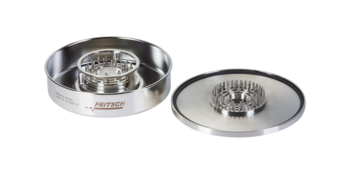
For grinding without a sieve for the most difficult, medium-hard, oil- or grease containing materials such as waxes or paraffins, utilize the pin rotor and the corresponding grinding chamber lid with pin insert for grinding entirely without a sieve ring.
PIN INSERT FOR GRINDING WITHOUT A SIEVE
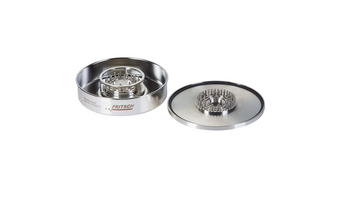
consisting of pin rotor and grinding chamber lid with pin insert.
For grinding without a sieve for the most difficult, medium-hard, oil or grease containing materials such as waxes or paraffins.
To discharge and collect large quantities which need to be ground use the conversion kit for grinding large quantities.
ACCESSORIES FOR GRINDING LARGE QUANTITIES

Regardless of the specific configuration of rotor, sieve rings, impact bar or pin insert, you can grind large quantities with the special conversion kit. Consisting of a special collecting vessel with outlet and flange-mount nylon support sack for easily replaceable paper filter bags. This allows the comminution of sample quantities of up to 1 litre in a single step without the need to open the grinding chamber and empty the collecting pan during the process.
ACCESSORIES FOR GRINDING LARGE QUANTITIES
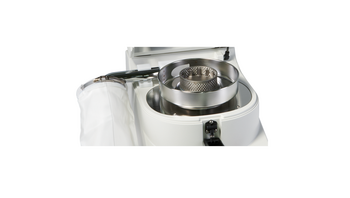
consisting of pan with outlet and flange-mount nylon support sack (outside) for the paper filter bag (inside).
Regardless of the specific configuration of rotor, sieve rings, impact bar or pin insert, the PULVERISETTE 14 is capable of grinding of large quantities with the special conversion kit: Consisting of a special collecting vessel with outlet and flange-mount nylon support sack for easily replaceable paper filter bags. This allows the comminution of sample quantities of up to 1 litre in a single step without the need to open the grinding chamber and empty the collecting pan during the process.
Our suggestion: During grinding of very light materials, the material yield can be significantly improved by the high air circulation of the conversion kit for grinding large quantities – even when grinding smaller quantities!
Another suggestion: During grinding of temperature-sensitive samples, the conversion kit for grinding large quantities with its large nylon support sack ensures a high air throughput, resulting in even better cooling.
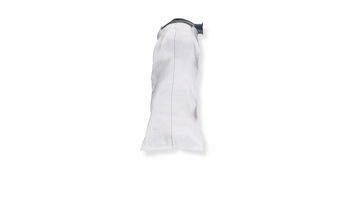
Set of paper filter bags for conversion kit for grinding large quantities
Set = 20 pieces paper filter bags
SAMPLE EXHAUSTION with CYCLONE SEPARATORS
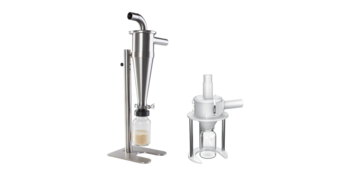
The combination of the FRITSCH Variable Speed Rotor Mill PULVERISETTE 14 classic line with the FRITSCH Cyclone separators is ideal for ultra-fine grinding of temperature-sensitive samples like powder coatings and plastic samples or for smooth pre-crushing and fine grinding of hard-brittle to soft, fatty or samples with residual moisture.
Two models are available: High performance Cyclone separator and small volume Cyclone separator.
High-performance CYCLONE SEPARATOR and ACCESSORIES

The compact Fritsch high-performance cyclone which is made completely out of stainless steel 316L, is particularly indispensable in the analytical sector and pharmaceutical industries. Due to its high surface quality, it offers enhanced resistance to corrosive media such as alkalis and acids, but particularly to media containing chlorides – and is especially easy to clean with a wide range of possible cleaning agents, without leaving any residues. The cyclone can also be fully dismantled, meaning that it can be completely emptied, flooded and sterilised.
Your advantage: reliable protection against cross-contamination.
| General specifications | |
| Material | Stainless steel – 1.4301 |
| ISO/EN/DIN code | X5CrNi1810 |
| Chemical composition | |
| Element | Share % |
| Iron – Fe | 66.805 |
| Carbon – C | 0.070 |
| Silicon – Si | 1.000 |
| Manganese – Mn | 2.000 |
| Phosphorus – P | 0.045 |
| Sulphur – S | 0.030 |
| Chromium – Cr | 19.5 |
| Nickel – Ni | 10.5 |
| Nitrogen – N | 0.110 |
| Physical and mechanical properties | |
| Density | 7.8 g/cm³ |
| Hardness | HRB 96 |
Explanations on hardness data
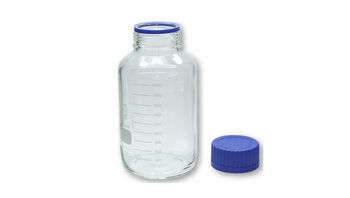
Sample glass 1 litre for sample exhaustion with the high-performance Cyclone separator.

The sample glass with 2 litres volume is recommended for sample exhaustion with the high-performance Cyclone separator for sample discharges larger than 1000 ml, since only a 1 litre sample glass is included in the delivery of the high-performance Cyclone separator.

The sample glass with 5 litres volume is recommended for sample exhaustion with the high-performance Cyclone separator for sample discharges larger than 1000 ml, since only a 1 litre sample glass is included in the delivery of the high-performance Cyclone separator.
Small volume Cyclone Separator and accessories
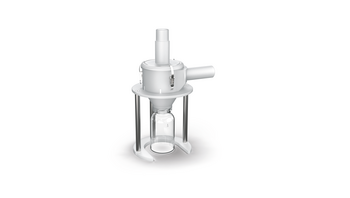
Small volume cyclone made of plastic for sample exhaustion of small sample quantities, incl. 250 ml sample glass.
We designed the compact Fritsch small volume cyclone especially for exhaustion of small sample quantities. It is made of plastic, can be dismantled completely and cleaned in a dishwasher for reliably preventing contaminations.
The comminuted sample is collected in a 250 ml sample glass, in which it can also be transported and stored. Alternatively a sample glass 500 ml can also be screwed-on and ordered: order no. 27.1460.00.
The small volume cyclone can be combined with the exhaust system order no. 43.9070.00 or can also be used with the supplied fine-dust filter 80-100 µm for passive utilisation. Replacement fine-dust-filters 80-100 µm can be reordered: order no. 45.8218.16.
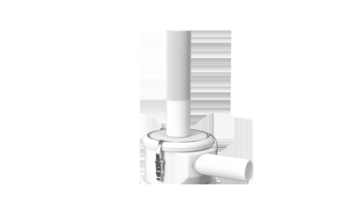
Replacement fine-dust filter 80 - 100 µm for small volume Cyclone separator for passive utilisation.

Replacement fine-dust filter 35 – 40 μm for small volume Cyclone separator for passive utilisation.
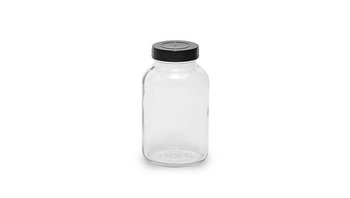
Sample bottle with screw lid, thread of sample bottle GL55.
Sample bottle can be used with dividing heads, division ratio 1:8.
Furthermore a sample vessel 32 ml with lid, article-number 83.3190.16, is available, which can be inserted in the sample bottles 250 ml and 500 ml for dividing smallest sample quantities.
Sample glass can also be used for sample exhaustion with the small volume Cyclone separator.

Sample bottle with screw lid, thread of sample bottle GL55, sample bottle can be used with dividing heads, division ratio 1:8 and 1:10.
Furthermore a sample vessel 32 ml with lid, article-number 83.3190.16, is available, which can be inserted in the sample bottles 250 ml and 500 ml for dividing smallest sample quantities.
The sample glass is recommended for sample exhaustion with the small volume Cyclone separator for sample discharges smaller than 500 ml, since only a 500 ml sample glass is included in the delivery of the small volume performance Cyclone separator.
Exhaust system for high-performance and small volume cyclone separators
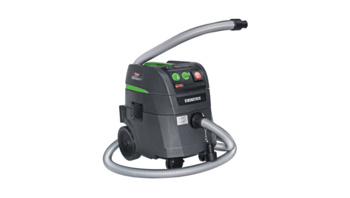
The exhaust system, dust category "M" according to DIN EN 60335-2-69 for 230 V/1~, 50/60 Hz, 1600 Watt is versatile:
For combination with the high performance and small volume cyclones.
To operate the FRITSCH Cyclones you need an exhaust system. The strong airflow ensures simple feeding, increases throughput, and reduces the thermal load of the samples. The high performance and small volume Cyclone separator can be combined with Universal Cutting Mills PULVERISETTE 19, the Rotor Mill P-14 and the Variable Speed Rotor Mill PULVERISETTE 14 classic line. The small volume cyclone can also be combined with the Rotor Mill P-14 premium line and Variable Speed Rotor Mill PULVERISETTE 14 classic line even for passive utilisation – without sample exhaust.
The high-performance cyclone is ideal for combination with the Universal Cutting Mills PULVERISETTE 19 large, the Cross Beater Mill PULVERISETTE 16 and the Disk Mill PULVERISETTE 13 premium line for optimal sample extraction and for comminution of larger quantities.
For cooling of the Rotor Mill P-14
By connecting the exhaust system with the connecting piece order no. 14.8128.00, the cooling of the mill can easily be enhanced.
For connecting to Disk Mill PULVERISETTE 13 premium line
The exhaust is simply connected to the PULVERISETTE 13 premium line and operated via a start and stop button on the instrument – for dust free comminution.
For connecting to the Jaw Crusher PULVERISETTE 1, Modell I + II classic line
Simply connect the exhaust system to the integrated connection of the PULVERISETTE 1. Fine dust arising during comminution is automatically removed. The exhaust system is also very useful when cleaning the grinding parts.
For connecting to the Disk Mill PULVERISETTE 13 classic line
The exhaust system can be easily connected to the PULVERISETTE 13 classic line. Fine dust arising during comminution is automatically removed. The exhaust system is also very useful when cleaning the grinding parts.
For exhaustion of the sample during dry measurement with the Laser Particle Sizers ANALYSETTE 22 NeXT
An exhaust system is necessary to ensure automatic sample exhaustion during dry measurement. When the measurement is completed it can also be easily used to manually clean the feeder.
Please note that the exhaust system article no. 43.9070.00, is not equipped with a fine filter and therefore dust may escape. Please consider the valid occupational health and safety regulations. This exhaust system is mostly recommended for dust-free grinding and the vacuuming of during the process developing fine dust in the upper part of the grinding chamber and for the cleaning of the grinding parts.
For vacuuming of the sample during dry measurement with the Laser Particle Sizers ANALYSETTE 22 NeXT, we recommended we recommend the exhaust system article no. 43.9060.00, which is equipped with a hose and an ultra-fine filter of dust class "H" according to DIN EN 60335-2-69, so that the escape of fine dust is reduced.
1 pack = 5 pieces
One pack is included in the scope of delivery of the exhaust system (article No. 43.9070.00).
These fleece filter bags should be used for the vacuuming off of fine, dry materials.
For the vacuuming off of coarse, wet materials are plastic bags available (article no. 43.9052.00).
1 pack = 5 pieces
One pack is included in the order of the exhaust system (article No. 43.9070.00).
These plastic bags should be used for the vacuuming off of coarse, wet materials.
For the vacuuming off of fine, dry materials are paper filter bags available (article no. 43.9055.00).
One filter set = 2 pieces is included in the order of the exhaust system (article No. 43.9070.00)
CERTIFICATION

For the independent utilization for the support of instrument qualification in the quality management system for the Variable Speed Rotor Mill Rotor PULVERISETTE 14 classic line.
CERTIFICATION
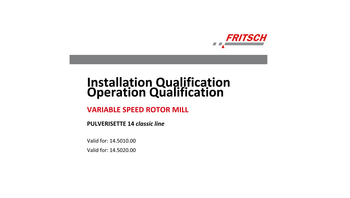
IQ/OQ documentation (questionnaire format - implementation not included)
for the independent utilization for the support of instrument qualification in the quality management system for the Variable-Speed Rotor Mill Rotor PULVERISETTE 14 classic line.
ACCESSORIES FOR AUTOMATIC SAMPLE FEEDING
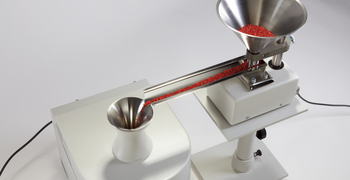
Combine your PULVERISETTE 14 classic line with the FRITSCH Vibratory Feeder LABORETTE 24 to ensure continuous feeding of the sample during the entire grinding process, even of smallest quantities. Due to a direct connection, the mill automatically matches the sample feeding to its load state at any given moment.
ACCESSORIES FOR AUTOMATIC SAMPLE FEEDING
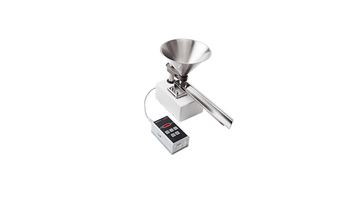
Vibratory Feeder LABORETTE 24 with V-shaped channel, funnel and control unit for 200-240 V/1~, 50-60 Hz, 25 Watt.
Details Vibratory Feeder LABORETTE 24

Vibratory Feeder LABORETTE 24 with V-shaped channel, funnel and control unit for 100-120 V/1~, 50-60 Hz, 25 Watt.
Details Vibratory Feeder LABORETTE 24
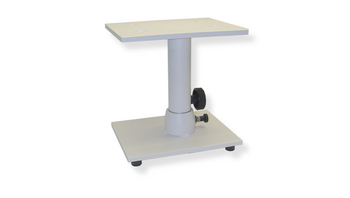
solid stand - height adjustable, rotatable, stable
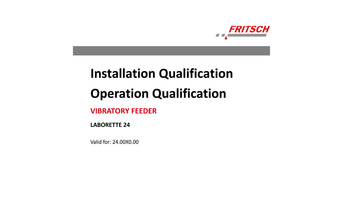
IQ/OQ documentation (questionnaire format - implementation by customer) for the independent utilization for the support of instrument qualification in the quality management system for the Vibratory Feeder LABORETTE 24.

